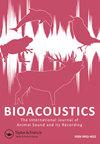Propagation of Guiana dolphin sounds in their habitat: measured transmission loss and influence of environmental factors
IF 2.1
4区 生物学
Q2 ZOOLOGY
Bioacoustics-The International Journal of Animal Sound and Its Recording
Pub Date : 2021-05-27
DOI:10.1080/09524622.2021.1929488
引用次数: 0
Abstract
ABSTRACT This study aims to determine the influence of distance and environmental parameters of water on Sotalia guianensis sounds. We used recordings of three distinct vocalisations for testing their propagation in places with different environmental characteristics in the Northeast and Southeast of Brazil. We observed that the propagation of all the sounds tested depended on the distance, turbidity, and concentration of oxygen dissolved in the water. Relative amplitude data for each sampled distance were smaller than the values predicted by the cylindrical spreading law. This result indicates that there are probably other factors that can influence sound propagation besides the distance in the sampled areas. The relative amplitude was also proportionally higher when there were lower levels of turbidity and higher concentration of dissolved oxygen in the water. From the data presented here, a model was generated that can be used as a tool to predict acoustic alterations of the environment against natural or anthropic changes in salinity, dissolved oxygen, and water turbidity. In addition, the methodology of this study is an important tool for conservation studies, for it can be replicated in other areas and with other species.圭亚那海豚声音在其栖息地的传播:测量的传播损失和环境因素的影响
摘要本研究旨在确定距离和水的环境参数对圭亚那索塔利亚声音的影响。我们使用了三种不同声音的录音来测试它们在巴西东北部和东南部具有不同环境特征的地方的传播。我们观察到,所有测试声音的传播都取决于距离、浊度和水中溶解氧的浓度。每个采样距离的相对振幅数据都小于圆柱形扩展定律预测的值。这一结果表明,除了采样区域中的距离之外,可能还有其他因素会影响声音传播。当水中浊度水平较低且溶解氧浓度较高时,相对振幅也相应较高。根据这里提供的数据,生成了一个模型,该模型可作为预测环境声学变化的工具,以对抗盐度、溶解氧和水浊度的自然或人为变化。此外,这项研究的方法是保护研究的重要工具,因为它可以在其他地区和其他物种中复制。
本文章由计算机程序翻译,如有差异,请以英文原文为准。
求助全文
约1分钟内获得全文
求助全文
来源期刊
CiteScore
4.50
自引率
0.00%
发文量
25
审稿时长
>12 weeks
期刊介绍:
Bioacoustics primarily publishes high-quality original research papers and reviews on sound communication in birds, mammals, amphibians, reptiles, fish, insects and other invertebrates, including the following topics :
-Communication and related behaviour-
Sound production-
Hearing-
Ontogeny and learning-
Bioacoustics in taxonomy and systematics-
Impacts of noise-
Bioacoustics in environmental monitoring-
Identification techniques and applications-
Recording and analysis-
Equipment and techniques-
Ultrasound and infrasound-
Underwater sound-
Bioacoustical sound structures, patterns, variation and repertoires

 求助内容:
求助内容: 应助结果提醒方式:
应助结果提醒方式:


